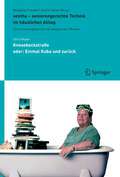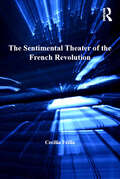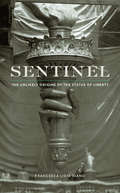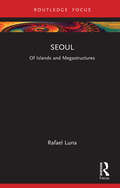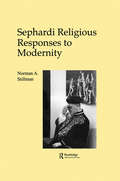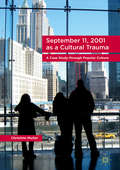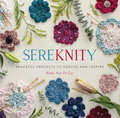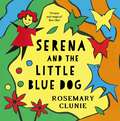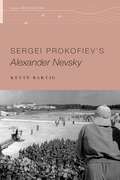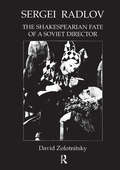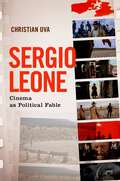- Table View
- List View
sentha - seniorengerechte Technik im häuslichen Alltag: Ein Forschungsbericht mit integriertem Roman
by Wolfgang Friesdorf Achim HeineAuch Senioren wollen ihren Haushalt selbstständig führen. Sie benötigen Geräte, die sie dabei unterstützen. Dieses Buch enthält das von Prof. Beitz initiierte und DFG-geförderte Projekt "SENTHA - seniorengerechte Technik im häuslichen Alltag" (TU Berlin). Eine multidisziplinäre Forschergruppe entwickelte Grundlagen für neue Produkte und Dienstleistungen. Senioren nahmen aktiv an dem Projekt teil und sind bis heute als "Senior Research Group" tätig.
The Sentimental in Chinese Cinema
by Hui MiaoThis book explores manifestations and perpetuations of the sentimental in Mainland Chinese cinema from the 1990s to the 2000s. A sentimental Chinese cinema – one that articulates notions of homecoming and belonging – emerged in the 1990s with its distinctive styles. The representations and configurations of this evolving style of Chinese cinematic expression are not only thought provoking in their own right, but also in the way they contrast with past forms of Chinese sentimental cinema and with sentimental aesthetics elsewhere in the world. These new representations have transformed established family centred expressions of the sentimental in Chinese cinema. The new sentimental emphasises togetherness and a yearning for belonging which often appear in the themes of homecoming and home-longing. This also forms a cultural resistance towards the increasingly alienating and isolating forces of globalisation and urbanisation. This book analyses the sociocultural conditions that have allowed for a renewed understanding of the sentimental and the cultural identity markers that are perpetually under contestation.
The Sentimental Theater of the French Revolution
by Cecilia FeillaSmoothly blending performance theory, literary analysis, and historical insights, Cecilia Feilla explores the mutually dependent discourses of feeling and politics and their impact on the theatre and theatre audiences during the French Revolution. Remarkably, the most frequently performed and popular plays from 1789 to 1799 were not the political action pieces that have been the subject of much literary and historical criticism, but rather sentimental dramas and comedies, many of which originated on the stages of the Old Regime. Feilla suggests that theatre provided an important bridge from affective communities of sentimentality to active political communities of the nation, arguing that the performance of virtue on stage served to foster the passage from private emotion to public virtue and allowed groups such as women, children, and the poor who were excluded from direct political participation to imagine a new and inclusive social and political structure. Providing close readings of texts by, among others, Denis Diderot, Collot d'Herbois, and Voltaire, Feilla maps the ways in which continuities and innovations in the theatre from 1760 to 1800 set the stage for the nineteenth century. Her book revitalizes and enriches our understanding of the significance of sentimental drama, showing that it was central to the way that drama both shaped and was shaped by political culture.
The Sentimental Theater of the French Revolution
by Cecilia FeillaSmoothly blending performance theory, literary analysis, and historical insights, Cecilia Feilla explores the mutually dependent discourses of feeling and politics and their impact on the theatre and theatre audiences during the French Revolution. Remarkably, the most frequently performed and popular plays from 1789 to 1799 were not the political action pieces that have been the subject of much literary and historical criticism, but rather sentimental dramas and comedies, many of which originated on the stages of the Old Regime. Feilla suggests that theatre provided an important bridge from affective communities of sentimentality to active political communities of the nation, arguing that the performance of virtue on stage served to foster the passage from private emotion to public virtue and allowed groups such as women, children, and the poor who were excluded from direct political participation to imagine a new and inclusive social and political structure. Providing close readings of texts by, among others, Denis Diderot, Collot d'Herbois, and Voltaire, Feilla maps the ways in which continuities and innovations in the theatre from 1760 to 1800 set the stage for the nineteenth century. Her book revitalizes and enriches our understanding of the significance of sentimental drama, showing that it was central to the way that drama both shaped and was shaped by political culture.
Sentinel: The Unlikely Origins of the Statue of Liberty
by Francesca Lidia VianoIcon of freedom and multiethnic democracy, memorial to Franco-American friendship—the lofty meanings we accord the Statue of Liberty today obscure its turbulent origins in 19th-century politics and art. Francesca Lidia Viano reveals that vibrant history in the fullest account yet of the people and ideas that brought the lady of the harbor to life.
Seoul: Of Islands and Megastructures (ISSN)
by Rafael LunaThis book focuses on understanding how a megacity like Seoul can be read as a formal architectural composition and not an endless urban sprawl.In a broader sense, the book discusses the dichotomy between city and urbanization: “city” being an architectural problem of bounded forms, while “urbanism” is an infrastructural project of expansion. It is an uncontested reality that urbanization is a continuous global process that has produced nebulous conurbations labeled as megacities. These expand beyond the virtual administrative boundary of any said “city,” producing a discrepancy between an area of administrative control and the real physical condition of human settlement. If there were a better formal understanding of megacities through their typological architectural conditions, then there could be a better assessment of the qualitative state of urbanization. Avant-garde groups from the 1950s, 1960s, and 1970s such as Team X, the Situationist, the Structuralist, and the Metabolist worked with ideas of megaforms and megastructures to address this issue. Although most of these proposals remained as paper architecture, this book reevaluates some of these ideas for the 21st-century megacity, using Seoul as a case study due to its clear typological formations produced over its diff erent periods of governance. The aim is to present the concept for an infra-architectural hybrid model of typological islands and subterranean megastructure that organizes Seoul as a fl exible multi-linear city.This book will be of interest to academics and students of architecture, urban geography, and Asian studies.
Seoul: Of Islands and Megastructures (ISSN)
by Rafael LunaThis book focuses on understanding how a megacity like Seoul can be read as a formal architectural composition and not an endless urban sprawl.In a broader sense, the book discusses the dichotomy between city and urbanization: “city” being an architectural problem of bounded forms, while “urbanism” is an infrastructural project of expansion. It is an uncontested reality that urbanization is a continuous global process that has produced nebulous conurbations labeled as megacities. These expand beyond the virtual administrative boundary of any said “city,” producing a discrepancy between an area of administrative control and the real physical condition of human settlement. If there were a better formal understanding of megacities through their typological architectural conditions, then there could be a better assessment of the qualitative state of urbanization. Avant-garde groups from the 1950s, 1960s, and 1970s such as Team X, the Situationist, the Structuralist, and the Metabolist worked with ideas of megaforms and megastructures to address this issue. Although most of these proposals remained as paper architecture, this book reevaluates some of these ideas for the 21st-century megacity, using Seoul as a case study due to its clear typological formations produced over its diff erent periods of governance. The aim is to present the concept for an infra-architectural hybrid model of typological islands and subterranean megastructure that organizes Seoul as a fl exible multi-linear city.This book will be of interest to academics and students of architecture, urban geography, and Asian studies.
Sephardi Religious Responses/M
by StillmanFirst Published in 1995. Routledge is an imprint of Taylor & Francis, an informa company.
Sephardi Religious Responses/M
by StillmanFirst Published in 1995. Routledge is an imprint of Taylor & Francis, an informa company.
September 11, 2001 as a Cultural Trauma: A Case Study through Popular Culture
by Christine MullerThis book investigates the September 11, 2001 attacks as a case study of cultural trauma, as well as how the use of widely-distributed, easily-accessible forms of popular culture can similarly focalize evaluation of other moments of acute and profoundly troubling historical change. The attacks confounded the traditionally dominant narrative of the American Dream, which has persistently and pervasively featured optimism and belief in a just world that affirms and rewards self-determination. This shattering of a worldview fundamental to mainstream experience and cultural understanding in the United States has manifested as a cultural trauma throughout popular culture in the first decade of the twenty-first century. Popular press oral histories, literary fiction, television, and film are among the multiple, ubiquitous sites evidencing preoccupations with existential crisis, vulnerability, and moral ambivalence, with fate, no-win scenarios, and anti-heroes now pervading commonly-told and readily-accessible stories. Christine Muller examines how popular culture affords sites for culturally-traumatic events to manifest and how readers, viewers, and other audiences negotiate their fallout.
September 11, 2001 as a Cultural Trauma: A Case Study through Popular Culture
by Christine MullerThis book investigates the September 11, 2001 attacks as a case study of cultural trauma, as well as how the use of widely-distributed, easily-accessible forms of popular culture can similarly focalize evaluation of other moments of acute and profoundly troubling historical change. The attacks confounded the traditionally dominant narrative of the American Dream, which has persistently and pervasively featured optimism and belief in a just world that affirms and rewards self-determination. This shattering of a worldview fundamental to mainstream experience and cultural understanding in the United States has manifested as a cultural trauma throughout popular culture in the first decade of the twenty-first century. Popular press oral histories, literary fiction, television, and film are among the multiple, ubiquitous sites evidencing preoccupations with existential crisis, vulnerability, and moral ambivalence, with fate, no-win scenarios, and anti-heroes now pervading commonly-told and readily-accessible stories. Christine Muller examines how popular culture affords sites for culturally-traumatic events to manifest and how readers, viewers, and other audiences negotiate their fallout.
SereKNITy: Peaceful Projects to Soothe and Inspire
by Nikki Van De CarSereKNITy: Peaceful Projects to Soothe and Inspire weaves mindful crafting and peaceful reflection into this simple, yet beautiful, collection of knitting and crochet patterns.The projects here are not the complicated sweater patterns found in traditional knitting guides, but simple, beautiful objects anyone can create. Practical crafts, like fingerless gloves and mug cozies, are featured alongside more meditative patterns, like granny squares and crocheted flowers. Each is paired with an inspirational, intention-setting prompt and falls under an overarching theme-Color, Texture, or Structure-that encourages knitters and crocheters of all skill levels to be fully present in the moment.Author and crafter Nikki Van De Car gently guides readers to look inward as they work, releasing their anxiety as they create something beautiful. For experienced knitters and novices alike, this is meditative crafting of the very best kind.
SereKNITy: Peaceful Projects to Soothe and Inspire
by Nikki Van De CarSereKNITy: Peaceful Projects to Soothe and Inspire weaves mindful crafting and peaceful reflection into this simple, yet beautiful, collection of knitting and crochet patterns. The projects here are not the complicated sweater patterns found in traditional knitting guides, but simple, beautiful objects anyone can create. Practical crafts, like fingerless gloves and mug cozies, are featured alongside more meditative patterns, like granny squares and crocheted flowers. Each is paired with an inspirational, intention-setting prompt and falls under an overarching theme-Color, Texture, or Structure-that encourages knitters and crocheters of all skill levels to be fully present in the moment. Author and crafter Nikki Van De Car gently guides readers to look inward as they work, releasing their anxiety as they create something beautiful. For experienced knitters and novices alike, this is meditative crafting of the very best kind.
Serena and the Little Blue Dog
by Rosemary ClunieA beautiful gift book and an original, modern fairy tale. Serena's adventure is full of charm and timeless magic, written in Rosemary Clunie's sparkling prose and illustrated in striking colour and collage.'Once upon a time a little girl called Serena lived in a cottage in the woods. She was friends with all the birds and animals of the forest. But what she really wanted was a special friend of her own.' When Serena meets the little blue dog, she names him Haiku and they become best of friends. But one day Haiku grows too big for Serena and her cottage in the woods. Together they travel to the edge of the forest, past fields of sunflowers and bright lakes to visit the green mountain bird, the red snake and the yellow fish. But it is the blue lady in a castle far away to the east who, by the magic of three stones, can help Serena find the answer.
Serene Urbanism: A biophilic theory and practice of sustainable placemaking
by Phillip James TabbSerenity is becoming alarmingly absent from our daily existence, especially within the urban context. Time is dense and space is tumultuous. The idea of the serene has gained currency in postmodern discussions, and when combined with urbanism conjures questions, even contradictions, as the two ideas seem improbable yet their correspondence seems so inherently desirable. Integrated, these two constructs present design challenges as they manifest in differing ways across the rural–urban transect. In response, Part I of this book establishes the theoretical framework through different contemporary perspectives, and concludes with a clear explanation of a theory of serene urbanism. The positive characteristics of urbanism and beneficial qualities of the serene are explored and related to sustainability, biophilia, placemaking and environmental design. Both principles and examples are presented as compelling portraits for the proposal of these new urban landscapes. Part II of the work is an in-depth exploration and analysis of serene urban ideas related to the intentional community being created outside of Atlanta, Georgia, USA. "Serenbe" is the name given to this place to commemorate the value and nuance between the serene and urban.
Serene Urbanism: A biophilic theory and practice of sustainable placemaking
by Phillip James TabbSerenity is becoming alarmingly absent from our daily existence, especially within the urban context. Time is dense and space is tumultuous. The idea of the serene has gained currency in postmodern discussions, and when combined with urbanism conjures questions, even contradictions, as the two ideas seem improbable yet their correspondence seems so inherently desirable. Integrated, these two constructs present design challenges as they manifest in differing ways across the rural–urban transect. In response, Part I of this book establishes the theoretical framework through different contemporary perspectives, and concludes with a clear explanation of a theory of serene urbanism. The positive characteristics of urbanism and beneficial qualities of the serene are explored and related to sustainability, biophilia, placemaking and environmental design. Both principles and examples are presented as compelling portraits for the proposal of these new urban landscapes. Part II of the work is an in-depth exploration and analysis of serene urban ideas related to the intentional community being created outside of Atlanta, Georgia, USA. "Serenbe" is the name given to this place to commemorate the value and nuance between the serene and urban.
Serge Bastarde Ate My Baguette: On the Road in the Real Rural France
by John DummerWhen John decamps to France to start up as an antiques dealer, he doesn’t count on meeting Serge Bastarde. The lovable rogue offers to teach John the tricks of the trade in return for help in a series of unscrupulous schemes. Filled with eccentric characters and unlikely adventures, this is a hilarious romp through the real rural France.
SERGEI PROKOFIEV'S ALEXAND NEVSKY OKS C (Oxford Keynotes)
by Kevin BartigAudiences have long enjoyed Sergei Prokofiev's musical score for Sergei Eisenstein's 1938 film Alexander Nevsky. The historical epic cast a thirteenth-century Russian victory over invading Teutonic Knights as an allegory of contemporary Soviet strength in the face of Nazi warmongering. Prokofiev's and Eisenstein's work proved an enormous success, both as a collaboration of two of the twentieth century's most prominent artists and as a means to bolster patriotism and national pride among Soviet audiences. Arranged as a cantata for concert performance, Prokofiev's music for Alexander Nevsky music proved malleable, its meaning reconfigured to suit different circumstances and times. Author Kevin Bartig draws on previously unexamined archival materials to follow Prokofiev's Alexander Nevsky from its inception through the present day. He considers the music's genesis as well as the surprisingly different ways it has engaged listeners over the past eighty years, from its beginnings as state propaganda in the 1930s to showpiece for high-fidelity recording in the 1950s to open-air concert favorite in the post-Soviet 1990s.
Sergei Prokofiev's Alexander Nevsky (Oxford Keynotes)
by Kevin BartigAudiences have long enjoyed Sergei Prokofiev's musical score for Sergei Eisenstein's 1938 film Alexander Nevsky. The historical epic cast a thirteenth-century Russian victory over invading Teutonic Knights as an allegory of contemporary Soviet strength in the face of Nazi warmongering. Prokofiev's and Eisenstein's work proved an enormous success, both as a collaboration of two of the twentieth century's most prominent artists and as a means to bolster patriotism and national pride among Soviet audiences. Arranged as a cantata for concert performance, Prokofiev's music for Alexander Nevsky music proved malleable, its meaning reconfigured to suit different circumstances and times. Author Kevin Bartig draws on previously unexamined archival materials to follow Prokofiev's Alexander Nevsky from its inception through the present day. He considers the music's genesis as well as the surprisingly different ways it has engaged listeners over the past eighty years, from its beginnings as state propaganda in the 1930s to showpiece for high-fidelity recording in the 1950s to open-air concert favorite in the post-Soviet 1990s.
Sergei Radlov: The Shakespearian Fate of a Soviet Director
by David ZolotnistkyFirst Published in 1996. Professor Zolotnitsky provides a picture of the life and work of Sergei Radlov - one of the most outstanding interpreters of Shakespeare on the Soviet stage in the 1930s. Sergei Radlov started as one of the left-wing directors among the disciples and companions of Vsevolod Meyerhold in post-revolutionary Russia. He directed Jack London, Ernst Toller, Evgeni Zamyatin and updated Aristophanes. In the latter he did "modern" operas, such as "The Love for Three Oranges" by Sergei Prokofiev and "Der ferne Klang" by Franz Schrecker.
Sergei Radlov: The Shakespearian Fate of a Soviet Director
by David ZolotnistkyFirst Published in 1996. Professor Zolotnitsky provides a picture of the life and work of Sergei Radlov - one of the most outstanding interpreters of Shakespeare on the Soviet stage in the 1930s. Sergei Radlov started as one of the left-wing directors among the disciples and companions of Vsevolod Meyerhold in post-revolutionary Russia. He directed Jack London, Ernst Toller, Evgeni Zamyatin and updated Aristophanes. In the latter he did "modern" operas, such as "The Love for Three Oranges" by Sergei Prokofiev and "Der ferne Klang" by Franz Schrecker.
Sergio Leone: Cinema as Political Fable
by Christian UvaSpectacle, myth, fable - these words instantly leap to mind when considering director Sergio Leone's celebrated films. His popularization of the Spaghetti Western genre, through works like A Fistful of Dollars (1964) and Once Upon a Time in the West (1968), continues to have a profound impact on filmmakers worldwide. In this exciting new study, Italian film scholar Christian Uva explores a side of Leone's works rarely before discussed: the political. Grappling with the contradictions between Leone's politically critical cinematic eye and his aversion to ideological classification, Sergio Leone: Cinema as Political Fable makes sense of how the director's internal political tensions shaped the radical themes of his Western fables. Looking at Leone and his films through a number of lenses, the book examines the elements of Italian history and identity interwoven in the director's stories, provides cultural context for a career spanning from Italy's fascist regime to Leone's death in 1989, and discusses the influences that formed Leone's directorial identity. Uva focuses in particular on the postmodernist theory behind Leone's works, revealing the critical basis of his stylistic and narrative innovations and newly analyzing the most iconic sequences from The Good, the Bad, and the Ugly (1967), Duck, You Sucker (1971), and Once Upon a Time in America (1984). An admirably thorough take on the man and his works, Sergio Leone: Cinema as Political Fable provides fresh perspective on a director long-established in cinema canon.
Sergio Leone: Cinema as Political Fable
by Christian UvaSpectacle, myth, fable - these words instantly leap to mind when considering director Sergio Leone's celebrated films. His popularization of the Spaghetti Western genre, through works like A Fistful of Dollars (1964) and Once Upon a Time in the West (1968), continues to have a profound impact on filmmakers worldwide. In this exciting new study, Italian film scholar Christian Uva explores a side of Leone's works rarely before discussed: the political. Grappling with the contradictions between Leone's politically critical cinematic eye and his aversion to ideological classification, Sergio Leone: Cinema as Political Fable makes sense of how the director's internal political tensions shaped the radical themes of his Western fables. Looking at Leone and his films through a number of lenses, the book examines the elements of Italian history and identity interwoven in the director's stories, provides cultural context for a career spanning from Italy's fascist regime to Leone's death in 1989, and discusses the influences that formed Leone's directorial identity. Uva focuses in particular on the postmodernist theory behind Leone's works, revealing the critical basis of his stylistic and narrative innovations and newly analyzing the most iconic sequences from The Good, the Bad, and the Ugly (1967), Duck, You Sucker (1971), and Once Upon a Time in America (1984). An admirably thorough take on the man and his works, Sergio Leone: Cinema as Political Fable provides fresh perspective on a director long-established in cinema canon.
Serial Drawing: Space, Time and the Art Object (Drawing In)
by Joe GrahamSerial Drawing offers a timely and rigorous exploration of a relatively little-researched art form. Serial drawings – artworks that are presented as singular works but are made up of distributed parts – are studied in fresh, contemporary terms with a novel philosophical approach, emphasizing both the way in which this unique form of visual art exists in the world, and how it is encountered by the beholder.Inspired by the quadruple framework of Graham Harman's object-oriented ontology, Joe Graham explores a variety of serial drawings according to the idea that, in being serially arrayed, such artworks constitute a rather particular form of art object: one which is both unified yet pluralised, visible yet withdrawn. Examining works by artists such as Alexei Jawlensky, Ellsworth Kelly, Hanne Darboven, Jill Baroff and Stefana McClure, Graham interrogates the manner in which serial drawings are able to be appreciated by the viewer who beholds them in object-oriented terms. This task is carried out by paying attention to the manner in which three tensions – space, time and seriality –emerge for consideration within the beholders performative encounter with the work: an encounter which is 'seen serially', and which the medium of drawing specifically directs their attention towards.
Serial Drawing: Space, Time and the Art Object (Drawing In)
by Joe GrahamSerial Drawing offers a timely and rigorous exploration of a relatively little-researched art form. Serial drawings – artworks that are presented as singular works but are made up of distributed parts – are studied in fresh, contemporary terms with a novel philosophical approach, emphasizing both the way in which this unique form of visual art exists in the world, and how it is encountered by the beholder.Inspired by the quadruple framework of Graham Harman's object-oriented ontology, Joe Graham explores a variety of serial drawings according to the idea that, in being serially arrayed, such artworks constitute a rather particular form of art object: one which is both unified yet pluralised, visible yet withdrawn. Examining works by artists such as Alexei Jawlensky, Ellsworth Kelly, Hanne Darboven, Jill Baroff and Stefana McClure, Graham interrogates the manner in which serial drawings are able to be appreciated by the viewer who beholds them in object-oriented terms. This task is carried out by paying attention to the manner in which three tensions – space, time and seriality –emerge for consideration within the beholders performative encounter with the work: an encounter which is 'seen serially', and which the medium of drawing specifically directs their attention towards.
